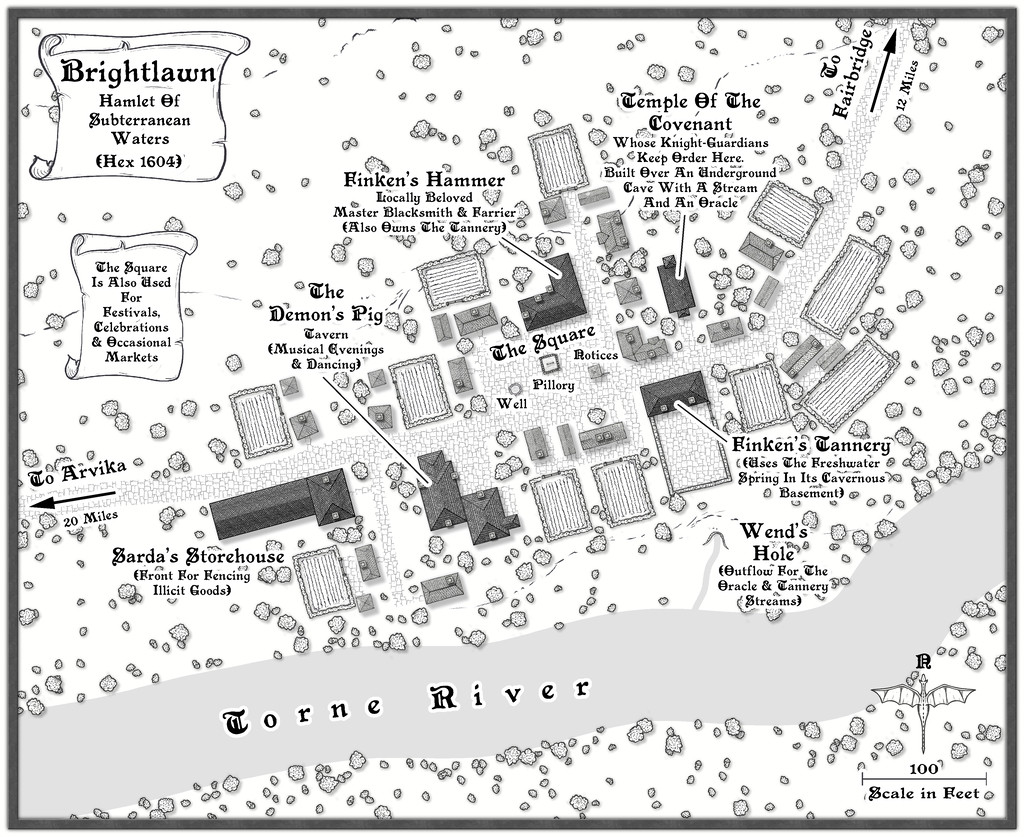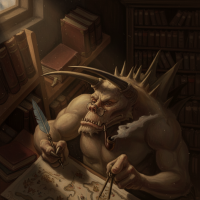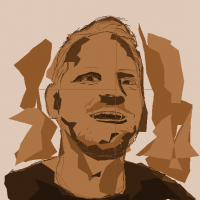
Wyvern
Wyvern
About
- Username
- Wyvern
- Joined
- Visits
- 3,134
- Last Active
- Roles
- Member
- Points
- 5,367
- Rank
- Cartographer
- Badges
- 24
-
[WIP] Community Atlas, 1,000 Maps Contest: Villages in The Whispering Wastes of Haddmark, Peredur
The eighth small settlement in this set is from Hex 1604, Brightlawn Hamlet:
No especially fancy elements were required here, although as a major river shown on the Atlas map for this continent, the Torne needed to look somewhat more imposing than the others to feature so far, and I did feel it would be useful to include an outlet into it from the subterranean streams that had been randomly decided-upon as part of this hamlet's layout. The settlement is also relatively close to the edge of the Siljan Hills, so a few more of the style's contour lines were added than normal. I did trial one of the cliff-line symbols for what became the Wend's Hole stream outlet as well, but that just didn't look right, mostly because the better-shaped of the cliff options is intended as a promontory, with the cliffs on its outer side. Instead I simply hand-traced the line of that cliff piece, and drew the little cliff-line markers to make it look more as if this was a hollow than a clifftop, which in combination with the contours and a mild shadow effect (suitably masked in part) seemed to work well enough.
Everything else was much as has become normal for these village maps, with properties of varying sizes and types, scattered vegetation and a few fields. Interestingly, the random options here from the Shadowdark tables came up with an area with a pillory and a "Wanted" noticeboard that wasn't a market place, although it makes such an obvious feature in the settlement, I decided occasional markets could happen there too. I added a well, and a hut by the noticeboard, since it made sense to develop that other local notices might be pinned-up there, thinking of medieval European settlements and how things such as broadsheets were presented publicly. The oracle in the cave below the small temple here adds a further note of mystery to the place, which hopefully helps make it seem a bit more "real"!
-
[WIP] Community Atlas, 1,000 Maps Contest: Villages in The Whispering Wastes of Haddmark, Peredur
Halfway point, or map five of the ten, if you prefer, is reached via Hex 1105, Osalin Village:
One interesting aspect for me as mapper with this sub-project was how readily the places each developed their own character, partly a result of their broader map setting, partly thanks to whatever features the Shadowdark random tables had come up with. In this case, there was the chance to map an unusually extensive area of burials, an aspect which truly defines the settlement, given that the area occupied by the dead is greater than that of the living village. Everything there was placed individually, to make sure things were never too neatly-ordered, although it's perhaps best not to peer too closely at what some of the repurposed symbols involved as the grave markers actually are! What's important at this map-view is the shape, texture and the shadows (or equivalent effects - there are some "Solid 10" shapes with variant Lighted Bevels in places, for instance). While time-consuming, it was rather satisfying to see the whole area growing in a more or less organic manner.
I'd already decided there might be hints of connections with a couple of the barrow-fields in hexes some way from the settlement on the Whispering Wastes area map, so adding a few more Solid 10 bevelled shapes for a few barrows closer-by seemed simply a natural adjunct. What was perhaps more surprising was the random tables provided by-chance an undertaker, properties hinting further at the ancientness, not to say weirdness, of the setting here, haunted warehouses and a little old temple suitable for hosting celebrations for the deceased (and anyone else at other times, of course). I've mentioned before, there are times when you start to wonder just how "random" these things really are! All I needed to add was a mill, a few contours and those barrow-shapes.
Onward now to the second half of the ten!
-
Panzer sample thread
-
[WIP] Atlas Contest: Village of Djayet (Gold Coast, west coast of Doriant)
Scalebars are fine in the Atlas.
You can change the font in any symbols like this in your map by making a new symbol with your preferred font in.
Select the symbol in Symbol Manager (in the Symbols drop-down menu), and Clone it, giving it a new name (this is very important, so you don't overwrite the original symbol).
Then, still in Symbol Manager, select your cloned symbol and click to Edit it. Draw your editing pane and then make whatever changes you wish - all the usual CC3+ tools are available to work on the symbol.
Once you're happy with the new version, click the cross box in the top right corner of the editing pane to dismiss it, and you'll get a terrifying message like this:
Despite the terror, click "Yes" - it's fine to do so with the cloned image.
Then your revised scalebar will be available to use in that map only.
-
Community Atlas: Towards a Solar System for Nibirum
Having been tasked with constructing a Solar System for the Community Atlas world of Nibirum, only a few things were clearly in-place at the outset. Expressed preferences, coupled with the nature of Nibirum as depicted in the surface maps and descriptions of the world itself so far, showed Nibirum to be an Earth-like planet in size and nature, including with seasonal effects and climatic zones, illuminated by a single Sol-type Sun. As noted before, I'd opted for a simplified 360-day year for the planet more or less from the start too. One, probably Luna-type Moon, was preferred at least (Quenten), although perhaps with one or more additional moons (Dogtag). I assumed impressive astronomical phenomena like solar and lunar eclipses would be required additionally, to provide Nibirum with extra flavour and reality. The solar eclipse factor gave a first physical parameter beyond the planet, since Earth-type total solar eclipses could only happen if one of Nibirum's moons had the same apparent size as its Sun.
The "multiple moons" question led me back to an idea I've played with previously in RPG settings, a variable effect or object usually seen in one part of the sky, when visible at all, which can become a convenient plot-device or subject of game-omen lore. I settled on a group of small cometary objects loosely "trapped" around the leading (L4) Lagrange point on Nibirum's orbit. The L4 and L5 Lagrange points on a body's orbit are gravitationally stable points where relatively small objects can become caught for very long periods (centuries to millennia). Their own pre-existing space-motions mean the objects usually continue to orbit about that stable point, so are not necessarily fixed in one spot. Each point lies more or less at 60° from the Sun as seen from the main body - such as a planet - forming one apex of a conveniently equilateral triangle, with the planet and Sun at the other two apices. This means, handily, that the planet's distance from its Sun is the same as the distance to either of these two Lagrange points. One lies 60° ahead of the Sun as seen from, say, Nibirum, the other 60° behind the Sun. Thus objects around Nibirum's leading Lagrange point would be visible close to the ecliptic in the morning sky before sunrise. So these little comets quickly became the Phoenix Asteroids Dawn Heralds.
Leaving the L5, trailing, Lagrange point empty - at least of anything visible from the surface of Nibirum - opens the door to scholarly speculation on the planet by those seeking symmetry. So maybe the misty stars of the Dawn Heralds shine showing the approaching richness (or otherwise) of the magical-mystical potential into which Nibirum will soon be moving (for a 360-day year, 60° = 60 days on Nibirum). That there is no equivalent group of Dusk Heralds could suggest that potential has been exhausted by the passage of the magical world of Nibirum, and will take much time - most of a year, say - to recover.
However, fitting a second, much smaller moon into the trailing Lagrange point on the orbit of Nibirum's main Moon seemed an ideal reworked symmetry, which also gave the planet more than one natural satellite. (The Lagrange point geometry is the same for the lunar orbit. Just substitute "Nibirum" for "Sun", and "main Moon" for "Nibirum" and "the planet" in the earlier description.) Thus was born the Red Moon, always faithfully following the larger White Moon around the sky. Not quite Gloranthan, though with names ultimately inspired by that fantasy world, via the old "White Bear, Red Moon" board wargame name, later revised as "Dragon Pass". Still more perfectly, and following from typical Earthly precedents of similar celestial behaviour, this can also be called the Dog Moon. So naturally, another name for the White Moon had to be the Q Moon (only from Nibirum's southern hemisphere, however, and then only by societies that recognise the significance of the apparent pattern forming said letter on the lunar disc).
Then 'twas time to see what else lay beyond Nibirum. There are of course numerous random solar system generators available for RPG use. Given the experimental nature of the whole Night Sky for Nibirum concept, I decided on one I've had for a while, but never used this way before, Galactic Baroque's "Instant Universe" (available for purchase via DriveThru RPG). This proved interesting, if not quite so straightforward, rapid, or complete as its name might imply.
Needing a Sol-like Sun, and given there is some scholarly debate still as to whether Earth's Sun is spectral type G2 or G4, I went with a class G3 sun of standard stellar type for Nibirum. That means it has sunspots from time to time, and a solar wind able to produce polar and sometimes mid-latitude aurorae, just as we see from Earth. At one solar mass, it seemed sensible to also go with a similar size to our Sun, thus Nibirum's Sun has a diameter of 1,400,000 kilometres (Sol's is 1,392,530 km; if you want miles, divide by 1.6).
Dicing on the Instant Universe tables provided the System with seven planets, their distances from the Sun, masses, sizes, natural satellites and so forth. Some of these features were slightly reworked or rounded-off to give a Solar System a little less mathematically-challenging for GMs to work with, and a few parameters not given by Instant Universe were added. The obvious place to fit Nibirum into this scheme was as the third planet outwards from the Sun, because that had a rounded distance of 130 million km, not far from Earth's own circa 150 million km.
Next came a series of calculations to find out what of all this could be seen from Nibirum. The Sun has an angular size of 0.62° from the planet (Sol is about 0.5° as seen from Earth), so that decided what minimum angular size the Q Moon needed to be to produce total eclipses for Nibirum. A diameter of 2,130 km at 200,000 km from Nibirum did the trick, with an option (just like for Earth) to have the lunar orbit's centre be slightly offset from Nibirum's centre, so the lunar disc can be sometimes a little too small to completely block the Sun, producing not-quite-total annular eclipses occasionally. Random rolls came up with a Dog Moon size of 350 km, so showing a tiny, faint, red disc about 0.1° in diameter as seen from the planet. The human eye can resolve objects as small as roughly 0.07°, so this is quite near that limit. No other planet appears as anything other than a bright to extremely brilliant star to the unaided eye from Nibirum.
I wanted the Dawn Heralds to be quite easily visible sometimes from the planet, despite no individual object within them being brighter than a 3rd magnitude star - and that only very occasionally. So I decided on them appearing as a somewhat nebulous patch, with at most a few brighter (4th or 5th magnitude) star-like points within, which collectively should be roughly 0.5° to 1.5° across as seen from Nibirum. This equates to a physical cross-sectional area of around 1 to 3½ million km or so, an actual size easily achievable by one quite modest comet of the kind visible from Earth. Such an angular size is similar to that of the Earth-visible Pleiades star cluster of 9 or 10 mostly 4th and 5th magnitude stars in the constellation of Taurus the Bull, about 1° east-west by 0.7° north-south. Despite the relative faintness of its stars (only one is 3rd magnitude), this cluster is a surprisingly easy object for the unaided eye in even quite strong twilight. The proximity of the stars to one another seems to make it easier to spot than just their brightnesses alone might indicate, so the Dawn Heralds can have a similar ability to "tickle" the vision of Nibirese morning sky-watchers.
Choosing what to depict on maps from all this, and how to do so, was somewhat more of a challenge. As I don't have Cosmographer installed, mapping came down to a choice between two main Annuals, CA 22 (October 2008) Star Systems or CA 80 (August 2013) HighSpace Star Systems. CA80 has a greater range of planet symbol options, and I needed two ringed planets, but in the end, CA22 just won out, as despite it having no ringed planet symbols, it did have the option for dynamic lighting effects on its planetary discs. Moreover, CA22's Mapping Guide includes a short tutorial on creating your own planet symbols with said dynamic lighting.
Thus with help from the GIMP (with which I freely confess I am a veritable novice), and still more from the Great and Powerful Monsen (who kindly allowed me to extract from his rotating-world graphics, and provided new, FT-generated, north and south polar views of Nibirum for the purpose), I constructed a small group of dynamic-lighting Nibirum planet symbols for use with the Atlas, one set showing six views of just the world, the other half-dozen onto which I GIMP-added some airbrushed white cloudy shapes, to make it look a little more homely.
[Image_10639]
After further deliberation, I decided on one chart to show the relative sizes and orbital distances of the planets, and a set of maps to show the satellites and features for each planet.
The relative-scale Solar System chart:
[Image_10640]
The five planet and satellite description maps:
[Image_10641]
[Image_10642]
[Image_10643]
[Image_10644]
[Image_10645]
Many of the details provided on these maps (collected with some further notes in a PDF to accompany them in the Atlas) cannot be discerned from Nibirum. However, I decided to preserve everything that had been randomly rolled or otherwise chosen, partly for the sake of completeness, partly because in some fantasy settings, there are ways of travelling to other planets - the classic sailing ships of the stars in some earlier incarnations of D&D, for instance. It seemed thus a useful adjunct to include this information for any who might wish to explore the Nibirum system more fully.
After that, I constructed some extra charts to help RPG GMs especially keep track of what's visible, where and when in Nibirum's night sky, starting with those Moons. -
Which style for... Post apocaliptic meshup
Yeah, I've been involved peripherally in a number of discussions elsewhere online lately regarding the use of AI art, including specifically that generated by Midjourney, because a lot of people - primarily artists - have become increasingly concerned about the direction this stuff is taking, most especially how the so-called AI systems are using artworks available online to generate their final images.
The matter is incredibly complex, and much of it remains uncertain, notably how copyright laws in various places pertain to AI-generated artworks, largely because they have never been legally tested this way (a couple of practicing US lawyers posted some very helpful discussions regarding the US situation a little while ago on one of the Discords I'm on, which were very enlightening in this regard).
I can do no better to help inform anyone here as to the current situation, than suggest those interested should read this blog posting from Dec 8th this year, by Jon Hodgson, a British "real" artist, RPG and game designer, who runs a company called Handiwork Games (which is where the blog is). Jon used Midjourney to generate much of the artwork in a new RPG he published this year, so he knows exactly what he's talking about from the genuine artist's perspective. He's also decided that any reprint of said RPG will have all the Midjourney artwork removed, to be replaced with his own, or other artists', real art, and he will not be using Midjourney, or other AI-generated artworks, again.
Personally, I've become very cautious about using any AI-generated artwork now, and would not do so in anything that wasn't purely for my own use.
-
The Expanse rpg; several starships, Annual scifi tiles and Cosmographer
My big problem with large ships is visualizing the layout/deck plans.
I forget whether you mentioned having a copy of any of the Metamorphosis Alpha RPG books or not now Jim, though I suspect from this comment probably not, as even the limited floorplans for the two complete decks, and the brief notes on all the others, in the first edition rules from 1976, would have given you a few pointers in this regard.
In one sense, Remy's right in suggesting it may help to think of the whole ship as like a huge city, actually more like a small country, given its gigantic size. Depending on how you envisage the entire craft as functioning, it's perfectly possible some of the decks might have a single function, or several major functions, each. Something like a farming deck for food production and air recycling, including breeding populations of domesticated animals, for instance, while there could be huge areas given over to parked-up machines on another deck for use on whatever planet the ship eventually reaches to colonise (since that's the primary reason such vast craft were envisaged originally). Elsewhere, there could be factories and machinery for use in them stored on another deck, again to get things functioning once the planet was reached, with maybe one entirely water-filled, for living aquatic foodstuffs, and as a water supply for the ship (could easily be segregated into fresh and sea water parts). Plus power supplies of varying kinds, of course.
It might help to work out what the total floor area is for the whole craft, and then compare that to a populated area on Earth somewhere, and see exactly what sort of features lie within a similar-sized zone, and what of those would be useful/essential on a ship destined to be in space for hundreds of years or more.
Hopefully in all this, we can help get you back on course!
-
Ancient maps
That 22-foot Roman Empire map is the Peutinger Table, aka Tabula Peutingeriana, and the Wikipedia page includes a high-res complete image of the whole - may take a while to load, however, as the full-size JPG is about 15 MB. This is the direct link to that Wikimedia image.
-
[WIP] Community Atlas, 1,000 Maps Contest: Villages in The Whispering Wastes of Haddmark, Peredur
Place four is from Hex 805, Toresk Village:
A somewhat more conventional, "open", layout for the next village in this group compared with last time's Ivan's Keep, if with more potentially untoward locations this time, including an overt reference to The Shimmering Cult, to add a little more linkage between features across the maps in this Haddmark mapping extravaganza. Those who read through last time's PDF notes here will have learnt the Druids from Hex 611 had a hand in creating the defences at Ivan's Keep (and may be responsible for the Goblin attacks on the place too, while The Shimmering Cult may be behind the Kobold attacks there...). Here, no similar problems, just a variety of dubious or curious goings-on. The map notes, as usual, have a little more detail.
Even so, I wanted the layout to be a bit odd, since the random rolls in the Shadowdark tables had come up with a Chaotic nature for the settlement (for those unfamiliar, most things in this RPG can be assigned an alignment - Law, Neutral or Chaos - as a keyword for GMs to apply as they choose to provide variant atmospheres for different places). So the village began nearer the river as a planned layout, but as more people came here, it spread more haphazardly eastwards, such that the older properties are now rather run-down and ill-favoured, despite also having a neater street pattern and fancy road-end walls.
-
City locations














